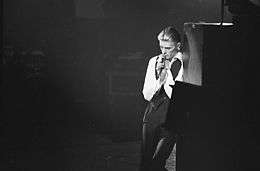The Thin White Duke
| The Thin White Duke | |
|---|---|
 | |
| First appearance | Station to Station |
| Created by | David Bowie |
| Portrayed by | David Bowie |
| Voiced by | David Bowie |
| Information | |
| Gender | Male |
| Occupation | Duke, aristocrat |

The Thin White Duke was David Bowie's 1976 persona and character, primarily identified with his album Station to Station (released that year) and mentioned by name in the title track, although Bowie had begun to adopt the 'Duke' persona during the preceding Young Americans tour and promotion. The persona's look and character are somewhat based on Thomas Jerome Newton, the titular humanoid alien played by Bowie in the 1976 film The Man Who Fell to Earth.
Characteristics
At first glance, the Thin White Duke appeared more "normal" than Bowie's previously flamboyant glam incarnations. Wearing a simple and impeccably stylish, cabaret-style wardrobe consisting of a white shirt, black trousers, and a waistcoat, the Duke was a hollow man who sang songs of romance with an agonised intensity while feeling nothing, "ice masquerading as fire".[1] The persona has been described as "a mad aristocrat",[1] "an amoral zombie",[2] and "an emotionless Aryan superman".[3] Bowie himself described the character as "A very Aryan, fascist type; a would-be romantic with absolutely no emotion at all but who spouted a lot of neo-romance."[4]
History
David Bowie, who had experience performing in experimental theatre before becoming famous as a musician, began adopting different performing personas in the early 1970s, most notably the glam alien Ziggy Stardust. He famously retired Ziggy in 1973, adopted the dystopian "Halloween Jack" persona for his Diamond Dogs album, and began appearing as the Thin White Duke during the tour for his next album, the "plastic soul" Young Americans.
The Thin White Duke was a controversial figure. While being interviewed in the persona in 1975 and 1976, Bowie made statements about Adolf Hitler and fascism that some interpreted as being positive or even pro-fascist.[5] The controversy deepened in May 1976 when, while acknowledging a group of fans outside of London Victoria station, he was photographed making what some alleged to be a Nazi salute. Bowie denied this, saying that he was simply waving and the photographer captured his image mid-wave.[6] As early as 1976, Bowie began disavowing his allegedly pro-Fascist comments and said that he was misunderstood. In an interview that year in the Daily Express, he explained that while performing in his various characters, "I'm Pierrot. I'm Everyman. What I'm doing is theatre, and only theatre... What you see on stage isn't sinister. It's pure clown. I'm using myself as a canvas and trying to paint the truth of our time on it. The white face, the baggy pants - they're Pierrot, the eternal clown putting over the great sadness."[7] In 1977 (after retiring the persona), Bowie stated that "I have made my two or three glib, theatrical observations on English society and the only thing I can now counter with is to state that I am NOT a Fascist".[8]
In later years, Bowie called the period from late 1974 until early 1977 which culminated in his Thin White Duke persona "the darkest days of my life" due to his "astronomical" cocaine usage.[9] He blamed his erratic behaviour and fascination with Nazi and occult symbols during that time on his precarious drug-addled mental state, and he claimed that he did not even remember recording Station to Station in 1976.[10] "I was out of my mind, totally crazed."[11] As his drug habit ate away at his physical and mental health, Bowie attempted to reduce his cocaine intake and phase out the Thin White Duke persona, whom he had come to see as "a nasty character indeed",[12] and later, "an ogre".[13] He left Los Angeles and settled in West Berlin in late 1976. He would live there for almost two years, moving on from the Thin White Duke era both musically and personally with his "Berlin Trilogy" albums (Low, "Heroes", and Lodger) in collaboration with Brian Eno and Tony Visconti.
References
- 1 2 Carr, Roy; Murray, Charles Shaar (1981). Bowie: An Illustrated Record. New York: Avon. pp. 78–80. ISBN 0-380-77966-8.
- ↑ Buckley, David (2000) [First published 1999]. Strange Fascination – David Bowie: The Definitive Story (2nd ed.). London: Virgin. p. 58. ISBN 0-7535-0457-X.
- ↑ Pegg, Nicholas (2004) [2000]. The Complete David Bowie. London: Reynolds & Hearn. pp. 297–300. ISBN 1-903111-73-0.
- ↑ Doggett, Peter (2011). The Man Who Sold The World: David Bowie And The 1970s.
- ↑ Borschel-Dan, Amanda (January 11, 2016). "From 'Heil Hitler' to 'Shalom, Tel Aviv,' the many incarnations of David Bowie". The Times of Israel.
- ↑ Paytress, Mark (January 2007). "The Controversial Homecoming". Mojo Classic (60 Years of Bowie): 64.
- ↑ Jean Rook, "Waiting for Bowie, and finding a genius who insists he's really a clown", Daily Express, May 1976
- ↑ Allan Jones, Goodbye to Ziggy and All That, Melody Maker, Oct. 1977
- ↑ Buckley, David (1999). Strange Fascination – David Bowie: The Definitive Story (1st ed.). London: Virgin. pp. 258–75. ISBN 1-8522-7784-X.
- ↑ Carr & Murray (1981): p. 11
- ↑ Sandford (1997): p. 158
- ↑ Wilcken, Hugo (2005). Low. New York: Continuum. p. 24. ISBN 0-8264-1684-5.
- ↑ White, Timothy (February 1978). "Turn and Face The Strange". Crawdaddy.
External links
- Alper, Arad (2007). "Taking it all the right way: Was David Bowie a Fascist?". Archived from the original on 7 April 2014.